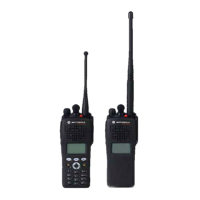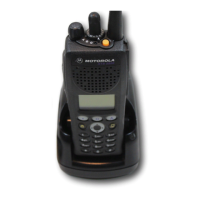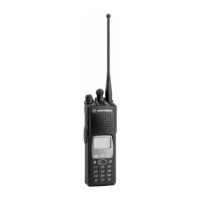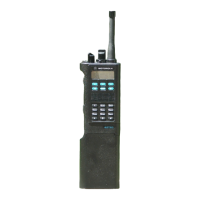Basic Theory of Operation
10
VOCON Basic
Theory of
Operation
The vocoder and controller (VOCON) circuitry contains the radio’s microcontrol
unit with its memory and support circuits, the DSP, its memory devices, and the
DSP-support IC, voltage regulators, audio, and power control circuits. Connected
to the VOCON circuitry are the display board, RF circuitry, keypad board, and
controls/universal flex.
The microcontrol unit controls receive/transmit frequencies, power levels, display,
and other radio functions, using either direct logic control or serial communications
paths to the devices.The microcontrol unit executes a stored program located in
the FLASH ROM. Data is transferred to and from memory by the microcontrol unit
data bus. The memory location from which data is read, or to which data is written,
is selected by the address lines.
The DSP-support IC is supplied with a 16.8 MHz clock from the RF circuitry. Both
the DSP and the microprocessor have their clocks generated by the DSP-support
IC. They can both be adjusted so that the harmonics do not cause interference with
the radio’s receive channel.
The regulator and power-control circuits include 3.3-volt analog, 3.3-volt digital,
and 5-volt regulators. The audio PA is sourced from 7.5V. The regulator’s power-
down mode is controlled by the microcontrol unit, which senses the position of the
on/off switch. The 5-volt regulator has an error pin for low-voltage resets.
The DSP performs signalling and voice encoding and decoding, as well as audio
filtering and volume control. This IC performs Private-Line®/Digital Private Line™
(PL/DPL) encode and alert-tone generation. The IC transmits pre-emphasis on
analog signals and applies a low-pass (splatter) filter to all transmitted signals. It
requires a clock on the EXTAL pin. An 8 kHz interrupt signal generated by the DSP-
support IC is also required for functionality. It is programmed using parallel
programming from the microcontrol unit.
The audio CODEC performs analog-to-digital (A/D), and digital-to-analog
conversions on audio signals. The DSP controls squelch, deviation, and executes
receiver and transmitter filtering. The DSP-support IC receives a 2.4 MHz clock,
and also receives data, which it formats for the DSP.

